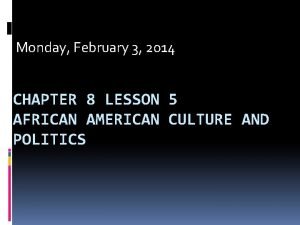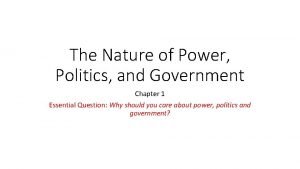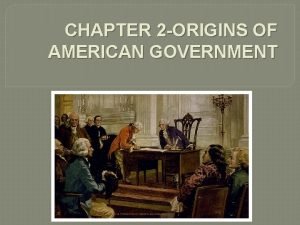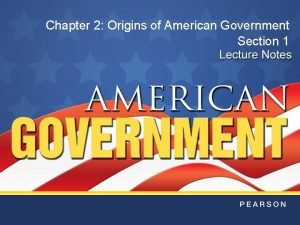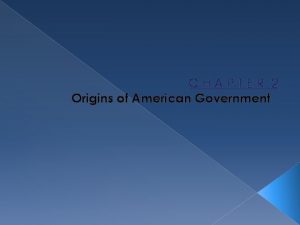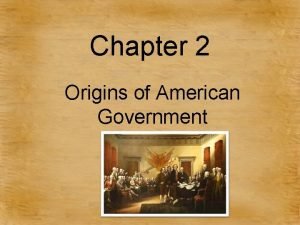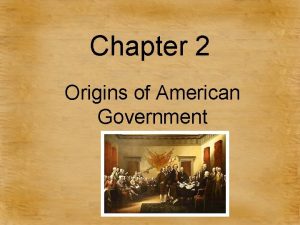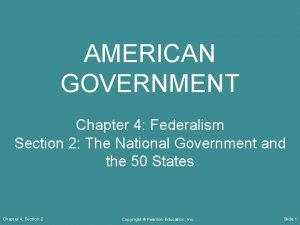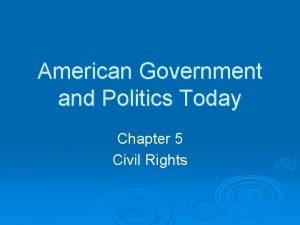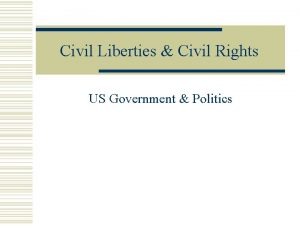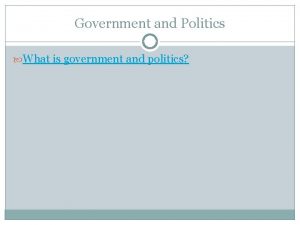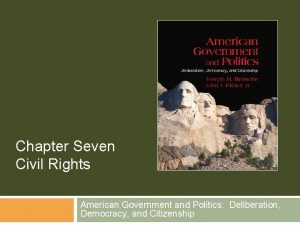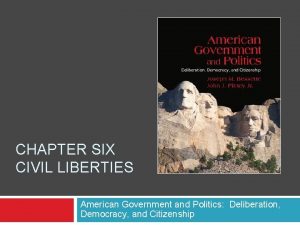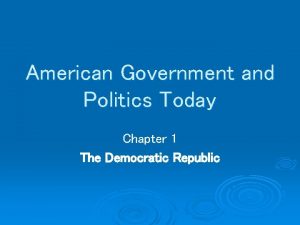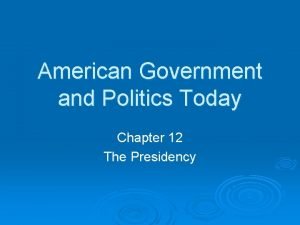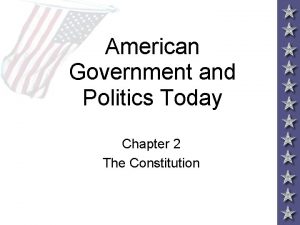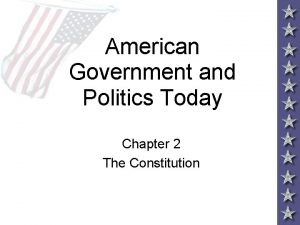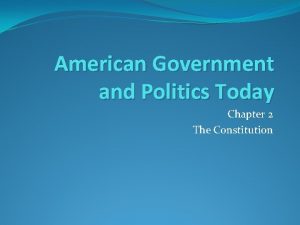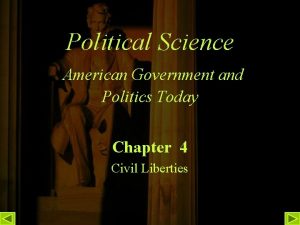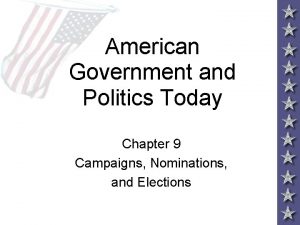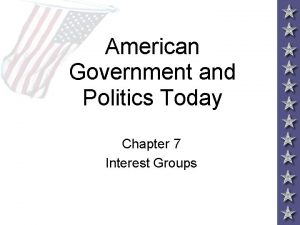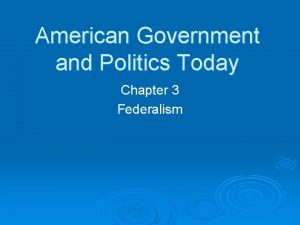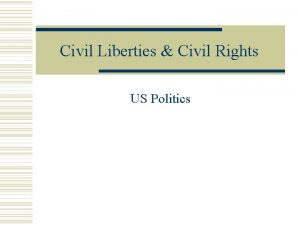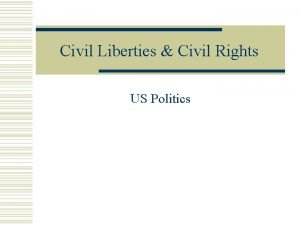American Government and Politics Today Chapter 4 Civil


















- Slides: 18

American Government and Politics Today Chapter 4 Civil Liberties

The Bill of Rights – Origins: colonists’ fear of a tyrannical government. – Federalists agreed to amend the Constitution to include a Bill of Rights after ratification, placing limitations on the government, and thus protecting citizens’ civil liberties.

The Bill of Rights and State Governments – While the Bill of Rights protected the people from the national government it did not protect the people from state governments. – In 1868 the Fourteenth Amendment became a part of the Constitution, imposing step-by-step, most of the Constitutional protections of civil liberties upon state governments.

Table 4 -1 Incorporating the Bill of Rights into the Fourteenth Amendment

Freedom of Religion – Separation of Church and State • Establishment Clause 1. Aid to Church-related schools 2. School Vouchers 3. School Prayer—Engel v. Vitale 4. Prayer outside the Classroom 5. The Ten Commandments 6. Teaching Evolution 7. Religious Speech

Free Exercise Clause – Guarantees the free exercise of religion; restrained when religious practices interfere with public policy. • Examples: the ability of school districts to select texts for students, and the requirement of vaccinations for school enrollment. – The Religious Freedom Restoration Act – Free Exercise in the Public Schools.

Freedom of Expression – No Prior Restraint – Protection of Symbolic Speech – Protection of Commercial Speech – Permitted Restrictions on Expression • Clear and Present Danger • Modifications: Grave and Probable Danger Rule – Unprotected Speech • Obscenity • Pornography/Internet Pornography • Slander – Campus Speech – Hate Speech

Freedom of the Press – Libel, a written defamation of character • Public figures must meet higher standards than ordinary people to win a libel suit. – A Free Press versus a Fair Trial • Gag orders: the right of a defendant to a fair trial supersedes the right of the public to “attend” the trial. – Films, Radio, and TV • Freedom of the press is no longer limited to just the print media though broadcast media do not receive the same protection as print media.

The Right to Assemble and Petition the Governor – The Supreme Court has held that state and local governments cannot bar individuals from assembling. State and local governments can require permits for such assembly so that order can be maintained. However the government cannot be selective as to who receives the permit. • Street Gangs. • Online Assembly

Privacy Rights – There is no explicit Constitutional right to privacy, but rather the right to privacy is an interpretation by the Supreme Court. – From the First, Third, Fourth, Fifth, and Ninth Amendments. – The right was established in 1965 in Griswold v. Connecticut.

Privacy Rights and Abortion – Roe v. Wade. In Roe v. Wade (1973) the court held that governments could not totally prohibit abortions because this violates a woman’s right to privacy. Government action was limited depending on the stage of the pregnancy. – Current Issue: “partial birth abortion”

Privacy Rights and The Right to Die – Cruzan v. Director, Missouri Department of Health (1997): a patient’s life support could be withdrawn at the request of a family member if there was “clear and convincing evidence” that the patient did not want the treatment. This has led to the popularity of “living wills. ” • What If There Is No Living Will? For married persons, the spouse is the relative with authority in this matter. – Physician-Assisted Suicide. The Constitution does not include a right to commit suicide. This decision left states much leeway to legislate on this issue. Since that decision in 1997, only the state of Oregon has legalized physician-assisted suicide.

Privacy Rights vs. Security Issues – Privacy rights have taken on particular events since September 11, 2001. For example, legislation has been proposed that would allow for “roving” wiretaps, which would allow a person (and his or her communications) to be searched, rather than merely a place. Such rules may violate the Fourth Amendment.

Rights of the Accused – Fourth Amendment • No unreasonable or unwarranted search or seizure. – No arrest except on probable cause. • Fifth Amendment • No coerced confessions. – No compulsory self-incrimination. – No double jeopardy. • Sixth Amendment • Legal counsel.

Rights of the Accused (cont. ) – Informed of charges. – Speedy and public jury trial. – Impartial jury by one’s peers. • Eighth Amendment • Reasonable bail. – No cruel or unusual punishment.

The Bill of Rights and the Accused – Miranda v. Arizona: requires the police to inform suspects of their rights (Miranda v. Arizona 1966). – Exceptions to the Miranda Rule. These include a “public safety” exception, a rule that illegal confessions need not bar a conviction if other evidence is strong, and that suspects must claim their rights unequivocally. – Video Recording of Interrogations. In t he future, such a procedure might satisfy Fifth Amendment requirements. – The Exclusionary Rule. This prohibits the admission of illegally seized evidence (Mapp v. Ohio 1961)

The Death Penalty – Cruel and Unusual Punishment? – The Death Penalty Today. Now 37 states allow the death penalty. – Time Limits for Death Row Appeals. – The 1996 Anti-Terrorism and Effective Death Penalty act limits appeals from death row. – Recently, DNA testing has led to the freeing of about a hundred death row inmates who were wrongly convicted, throwing doubt on the death penalty.

Figure 4 -1 States that Allow the Death Penalty
 Lesson 5 african american culture and politics
Lesson 5 african american culture and politics Chapter 20 whose government
Chapter 20 whose government Government unit 1 study guide
Government unit 1 study guide The nature of power politics and government
The nature of power politics and government Civil rights webquest
Civil rights webquest Chapter 2 american government
Chapter 2 american government Chapter 2 origins of american government vocabulary
Chapter 2 origins of american government vocabulary Chapter 2 origins of american government answer key
Chapter 2 origins of american government answer key Chapter 2: origins of american government worksheet answers
Chapter 2: origins of american government worksheet answers Chapter 2 lesson 1 origins of american government
Chapter 2 lesson 1 origins of american government Chapter 2 origins of american government
Chapter 2 origins of american government Chapter 4 federalism answer key
Chapter 4 federalism answer key For todays meeting
For todays meeting Today's class work
Today's class work Meeting objective
Meeting objective Characteristic of fingerprint
Characteristic of fingerprint Today's lesson or today lesson
Today's lesson or today lesson Today's lesson or today lesson
Today's lesson or today lesson Lesson 2: the history of american banking and banking today
Lesson 2: the history of american banking and banking today
